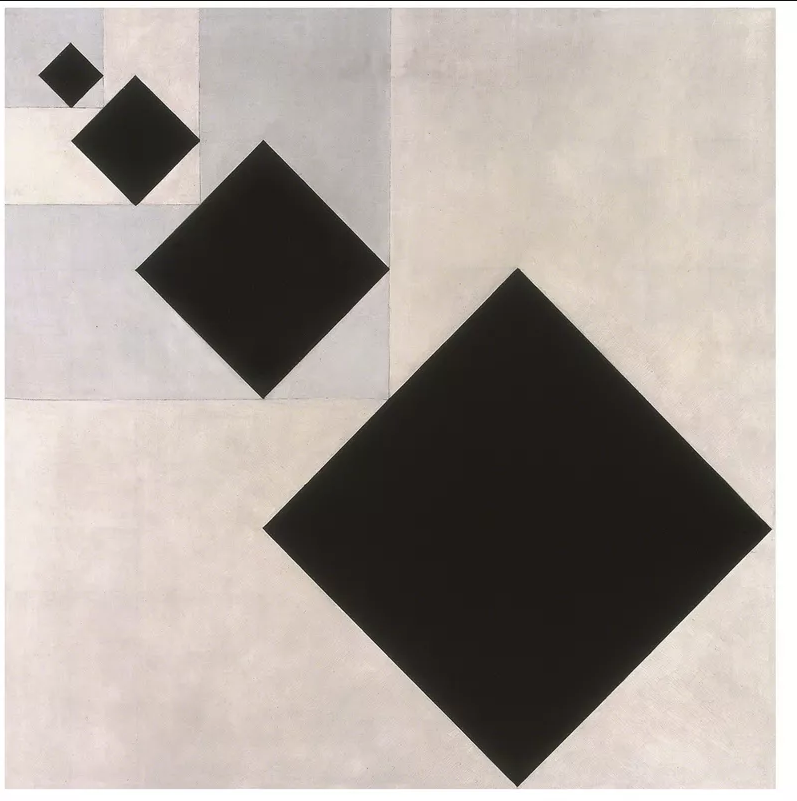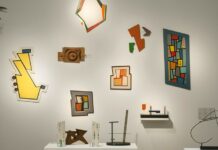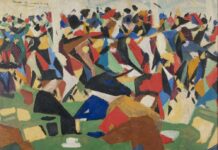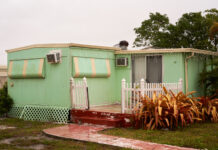Theo van Doesburg
Concrete Art, De Stijl, Neo-Plasticism, Bauhaus
DUTCH PAINTER, DESIGNER, AND ARCHITECT
Born: August 30, 1883 – Utrecht, Netherlands
Died: March 7, 1931 – Davos, Switzerland
Christian Emil Marie Küpper, who adopted the pseudonym Theo van Doesburg, was born in Utrecht, the Netherlands, on August 30, 1883. His first exhibition of paintings was held in 1908 in the Hague. In the early 1910s he wrote poetry and established himself as an art critic. From 1914 to 1916 van Doesburg served in the Dutch army, after which time he settled in Leiden and began his collaboration with the architects J. J. P. Oud and Jan Wils. In 1917 they founded the group De Stijl and the periodical of the same name; other original members were Vilmos Huszár, Piet Mondrian, Bart van der Leck, and Georges Vantongerloo. Van Doesburg executed decorations for Oud’s De Vonk project in Noordwijkerhout in 1917.
In 1920 he resumed his writing, using the pen name I. K. Bonset and later Aldo Camini. Van Doesburg visited Berlin and Weimar in 1921 and the following year taught at the Weimar Bauhaus, where he associated with Raoul Hausmann, Le Corbusier, Ludwig Mies van der Rohe, and Hans Richter. He was interested in Dada at this time and worked with Kurt Schwitters as well as Jean Arp, Tristan Tzara, and others on the review Mécano in 1922. Exhibitions of the architectural designs of Gerrit Rietveld, van Doesburg, and Cor van Eesteren were held in Paris in 1923 at Léonce Rosenberg’s Galerie l’Effort Moderne and in 1924 at the Ecole Spéciale d’Architecture.
The Landesmuseum of Weimar presented a solo show of van Doesburg’s work in 1924. That same year he lectured on modern literature in Prague, Vienna, and Hannover, and the Bauhaus published his Grundbegriffe der neuen gestaltenden Kunst (Principles of Neo-Plastic Art). A new phase of De Stijl was declared by van Doesburg in his manifesto of “Elementarism,” published in 1926. During that year he collaborated with Arp and Sophie Taeuber-Arp on the decoration of the restaurant-cabaret L’Aubette in Strasbourg. Van Doesburg returned to Paris in 1929 and began working on a house at Meudon-Val-Fleury with van Eesteren. Also in that year he published the first issue of Art concret, the organ of the Paris-based group of the same name. Van Doesburg was the moving force behind the formation of the group Abstraction-Création in Paris. The artist died on March 7, 1931, in Davos, Switzerland.
Theo Van Doesburg was one of the founders and leading theorists of De Stijl along with Piet Mondrian, which began in the Netherlands and flourished into one of the major inter-war movements. It advocated a simplified, geometric, and reductive aesthetic in the visual arts and argued that painting, design, and architecture should be fully integrated. Van Doesburg created numerous abstract paintings and designed buildings, room decorations, stained glass, furniture, and household items that exemplified De Stijl’s aesthetic theories and his personal ideas. He wrote numerous essays and treatises on geometric abstraction and De Stijl, published journals, and organized many exhibitions of works by De Stijl artists and related movements.
Van Doesburg’s personal version of De Stijl was called Elementarism, which emphasized subtle shifts in tones, tilting squares and rectangles at angles relative to the picture plane, and allowed straight horizontal and vertical lines to be colored, varied in length, and disconnected from one another.
Van Doesburg wanted to give De Stijl more variety, movement, and energy than found in Piet Mondrian’s personal version of the movement, which was called Neoplasticism. This small but crucial difference in his thinking led to Van Doesburg and Mondrian’s split in 1924.
Van Doesburg believed that art should be an absorbing, spatial, and environmental experience. This led him to create architectural designs, stained glass, interior decoration, furniture, and other functional, daily items that were carefully related to one another and were meant to be installed together for a holistic experience. Many of these were never actually built or manufactured.
Van Doesburg felt that abstraction’s unique value was its ability to achieve social order and universal harmony with its precise, orderly geometry and vibrant, contrasting colors. He also felt that his reductive method had spiritually and morally uplifting qualities. His Dancers series demonstrates both his abstraction, and the spiritual inspiration he found in it.
Childhood and Education
Theo van Doesburg was born in Utrecht, the Netherlands to Wilhelm Kupper and Henrietta Catherina Margadant. Originally named Christian Emile Marie Kupper, he considered his stepfather, Theodorus Doesburg, to be his natural father, eventually taking his stepfather’s name when he began his painting career. Van Doesburg served in the Dutch military and during World War I (from 1914 to 1916), he was stationed near Tilburg. He was married four times; the first three marriages ended in divorce and the fourth lasted until his death.
He trained in singing and acting before deciding to become a painter, and diverse interests continued to be a hallmark of his career. His first exhibition was in 1908, and starting in 1912 he supported his painting by writing for magazines. Until 1913 he explored traditional representational painting, greatly influenced by Vincent Van Gogh, and the then more modernist figurative styles. After reading Wassily Kandinsky’s autobiographical Ruckblicke, he had a revelation about the nature of painting and its connection to spirituality. He began to study Theosophy, which influenced his ideas about artistic harmony. The idea that painting originates in the mind changed his style, and he began working in a more personally expressive and painterly abstract style because of this. Two years later, his devotion to Kandinsky’s ideas and style of painting had waned considerably after exposure to Piet Mondrian’s paintings in 1915 while reviewing an exhibition on an assignment from a magazine.
Early Training
Theo van Doesburg Biography
In 1916, van Doesburg began to develop his distinct variation of De Stijl. He became convinced that painting, architecture and design should be completely integrated and that art should not only be a visual experience, but part of a larger, more encompassing spatial and physical environment. In October 1917, along with Piet Mondrian, Bart van der Leck, and J.J. Oud, he was one of the founders of the De Stijl movement, and its magazine, De Stijl. Van Doesburg was probably its most ardent supporter in the years to come, spreading the message of De Stijl across Europe, and editing and publishing the magazine until its end in 1931. De Stijl was the Dutch variation of the geometric abstraction that developed across Europe. It was characterized by long straight black lines used to define squares and rectangles that are filled in with white, grays, or primary colors.
In addition to editing, and writing for De Stijl, van Doesburg advocated for his theories and other artists’ ideas in various publications that he helped publish. Mécano, published in 1922-1923, was more concerned with Dada, another artistic movement he was greatly interested in and to which he contributed. Van Doesburg’s extensive traveling throughout Europe, including visits to France, Italy, Germany, and Spain, made him personally familiar with many of his contemporaries and their works and ideas. In these years, he organized many exhibits of Bauhaus, De Stijl, and Constructivist artists, and even some of Dada artists. He lectured on the ideas of De Stijl at the Bauhaus in 1921, moving to Weimar in 1922 to try and ingratiate himself with principal Bauhaus member, Walter Gropius. However he was never invited to become part of the Bauhaus faculty because the Bauhaus leaders considered his idea too dogmatic and narrow. Nevertheless, van Doesburg was tenacious; setting himself up next to the Bauhaus buildings and teaching interested students about Constructivism, Dada, and De Stijl.
While promoting De Stijl, van Doesburg collaborated with architects and designers as early as 1918, working on numerous projects with the architects J.J. Oud, Gerrit Rietveld, and Cornelis van Easteren. The architectural works that they created together reflected the De Stijl intention of integrating art, architecture, and design. Van Doesburg took the geometry and color of a De Stijl painting off of the canvas and transformed it into an architectural structure; the illustrations for the “Maison Particuliere” that he designed with van Easteren demonstrate this intention. Van Doesburg designed stained glass windows for a house that Oud was building in 1918, as well as the windows and interior decorations for apartment buildings in Rotterdam that Oud was working on from 1918 to 1920. However, this idealistic cooperation proved short-lived, as disagreements over designs and balancing how architecture would be complemented and enhanced with painting or decoration led to deep divisions among the artists and architects associated with the movement.
Besides architecture, van Doesburg explored structure in a different way by working in typography. In 1919 he designed an alphabet style that was severely reductive and geometric, which was intended for use in De Stijl posters, signs, decorations, and architecture. Interest in it flourished for only a few years. In the 1920’s he collaborated with Kurt Schwitters and Kate Steintz on a series of children’s books and fairy tale collections which used the typeface; he also designed book covers and posters incorporating his ideas on typography.
Further proving how varied his interests were, Dada also intrigued van Doesburg. He socialized with numerous Dada artists, creating Dada artworks as early as 1920. He felt that there were aesthetic and expressive benefits to shifting styles so radically. However, he had reservations about being associated too closely with Dada; perhaps because he felt that its irony, sarcasm, and pessimistic outlook conflicted too sharply with the utopian ideas of De Stijl. He wrote Dada poetry under the pen name “I.K. Bonset,” which means “I am a fool” in Dutch. He submitted poetry to De Stijl magazine, as well as editing the Dada magazine, Mecano. Most of his friends did not know until after his death that van Doesburg was “I.K. Bonset.” He even had his wife Nelly dress in drag as “I.K. Bonset” with a false mustache, smoking a pipe, and wearing an aviator’s helmet and goggles. Both participated in Dada performances, including a Dada tour of Holland with Kurt Schwitters.
Mature Period
In 1923 van Doesburg left Weimar and moved to Paris to be closer to Mondrian. Unfortunately, their personal and professional relationship soon dissolved. Previously, the two artists had only corresponded by mail. In person their divergent personalities were apparent: van Doesburg was extroverted and flamboyant, while Mondrian was introverted. These differences came to a head in 1924, leading to a rupture with Mondrian. The exact reason for the split has been contested among art historians, but many believe that it was due to opposing artistic ideas – primarily that Mondrian did not agree with the use of diagonals whereas van Doesburg insisted that they were a necessity. After the breakup, Van Doesburg further developed his artistic style, creating many paintings that constituted his Counter-Compositions series. These paintings reflect his development of Elementarism, his own variation on Mondrian’s Neoplasticism, which he felt, as evidenced by the split with Mondrian, had become too narrow and rigid in its insistent use of horizontal and vertical linear construction and the combination of only white and primary colors. Elementarism allowed for diagonal lines and triangles to create more varied, overlapping and interactive shapes in compositions that were still basically two-dimensional. It also used graduated tones of primary colors and shades of gray for more variety and interaction between colors, and lights and darks. There was a brief reconciliation when the two men accidentally met in a Parisian café in 1924.
While in the middle of this tumultuous time with Mondrian, van Doesburg worked with van Easteren on several designs for houses, some of which were exhibited but none of which were ever built. These designs involved broad geometric planes in primary colors that suggested or indicated planar divisions of space without creating clearly determined, but limiting, walls and ceilings. In 1926, van Doesburg was invited by Hans and Sophie Tauber Arp to collaborate with them on redesigning the Aubette Building in Strasbourg, so that it would have a café, dance hall, and movie theater. He worked on all aspects of these new parts of the building, from the rooms to their tables and chairs, and small furnishings. His recently developed concepts of Elementarism were used extensively in this project. However innovative his work was, the redesign was not well received by the public when the building re-opened in 1929, and it was soon replaced with more conservative decorations and designs.
Late Period
Theo van Doesburg Portrait
After the dissolution of Dada, while in Paris in 1929 van Doesburg helped create the group Art Concret and was one of the publishers of its short-lived journal. The group was partly a continuation of De Stijl, but went further, emphasizing geometrical abstract art that was considered the most radical and absolute formulation of abstraction. Van Doesburg’s manifesto “Basis of Concrete Painting”, published in the journal, is considered the foundational document of Concrete Art, that developed this philosophy over the following two decades and grew into a large, international movement. The Art Concret group only exhibited three times in 1930, at the Salon des Surindependants in Paris, Production Paris 30 in Zurich, and the International Exhibit of Post-Cubist Art in Stockholm. In 1932, Art Concret was absorbed into Abstraction-Creation, a larger and more robust organization that was established in 1931, partly with his support, and lasted until 1936.
Van Doesburg’s last major project was the house that he designed for himself and his wife in Meunon, France in 1930-1931. Unlike his work in the 1920s, this house was more reductive and restrained in forms and colors. However, he never saw the house to completion. After several years of poor health he died of a heart attack in 1931 in Davos, Switzerland. His wife, Nelly, lived in the house until her death in 1975.
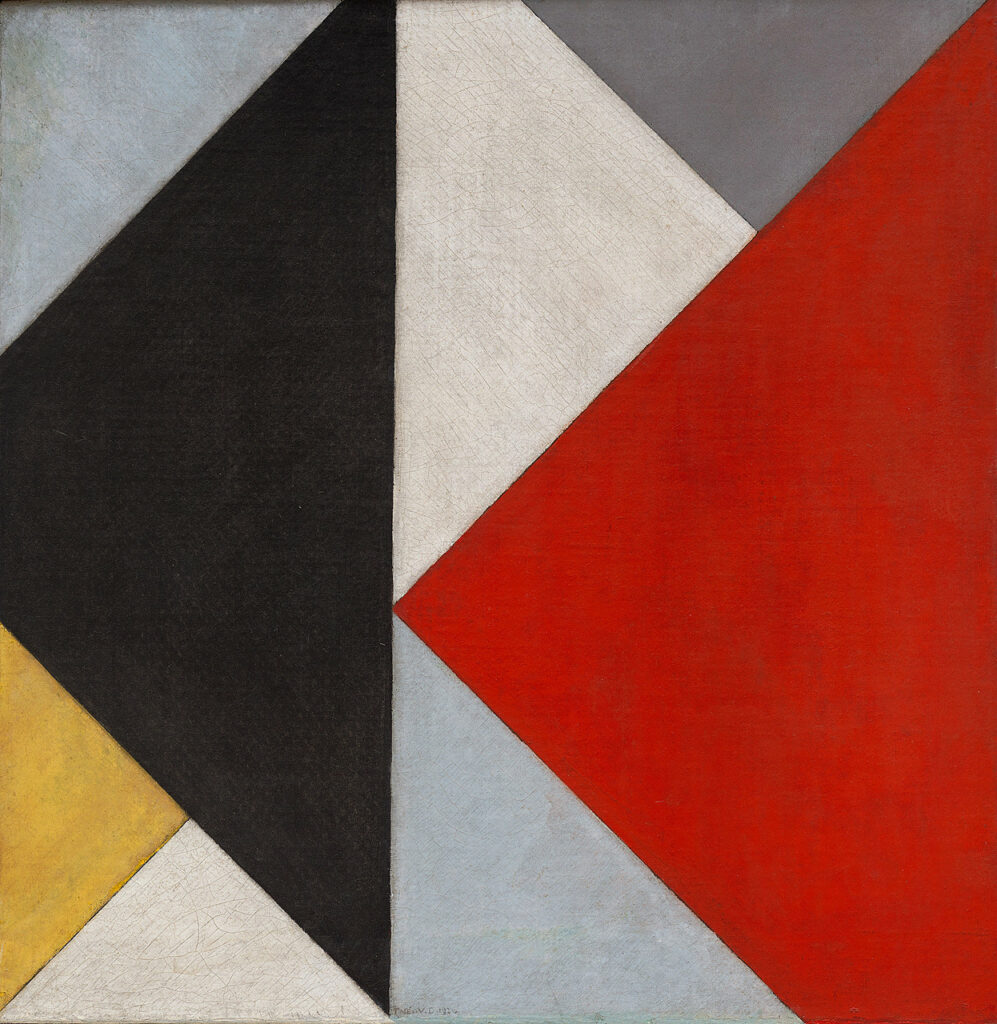
Artist: Theo van Doesburg
b. 1883, Utrecht, Netherlands; d. 1931, Davos, Switzerland
Title: Counter-Composition XIII
Date: 1925–26
Medium: Oil on canvas
Dimensions: 19 5/8 x 19 5/8 inches (49.9 x 50 cm)
Theo van Doesburg
Counter-Composition XIII (Contra-Compositie XIII)
About 1924 Theo van Doesburg rebelled against Piet Mondrian’s programmatic insistence on the restriction of line to vertical and horizontal orientations, and produced his first Counter-Composition. The direction consequently taken by Neo-Plasticism was designated “Elementarism” by van Doesburg, who described its method of construction as “based on the neutralization of positive and negative directions by the diagonal and, as far as color is concerned, by the dissonant. Equilibrated relations are not an ultimate result.”¹ Mondrian considered this redefinition of Neo-Plasticism heretical; he was soon to resign from the De Stijl group.
This canvas upholds the Neo-Plastic dictum of “peripheric” composition. The focus is decentralized and there are no empty, inactive areas. The geometric planes are emphasized equally, related by contrasts of color, scale, and direction. One’s eyes follow the trajectories of isosceles triangles and stray beyond the canvas to complete mentally the larger triangles sliced off by its edges. The placement of the vertical axis to the left of center and the barely off-square proportions of the support create a sense of shifting balance.
Lucy Flint
1. Quoted in Hans Ludwig C. Jaffé, De Stijl, 1917–1931: The Dutch Contribution to Modern Art (London: A. Tirnati, 1956), p. 26.
Source: https://www.guggenheim.org/artwork/1080


